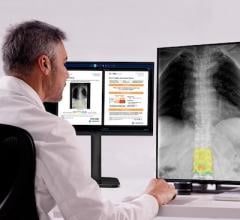
Radiologists want a bigger role in healthcare, one that allows them a say in patient management, ideally one that goes from diagnosis to therapy follow-up. They will get it only if they can demonstrate their involvement adds clinical value.
Improving patient outcomes is one route to this goal. Artificial intelligence (AI) may be the vehicle.
AI holds the potential for improved diagnosis. A San Francisco-based start-up called Enlitic is already pursuing this opportunity.
In the weeks leading up to RSNA 2015, Enlitic sent software engineers to about 80 medical imaging centers in Australia and Asia, bringing with them a deep learning algorithm designed for use on picture archiving and communication systems (PACS). The company hopes that this algorithm eventually will become smart enough to identify the signs of disease in every imaging modality in the centers, including magnetic resonance (MR), computed tomography (CT), ultrasound, X-ray and nuclear medicine.
Meanwhile, IBM is grooming Watson Health to help physicians make diagnoses. Intelligent machines may one day take the reins during the exam itself, optimizing scan protocols on the fly to home in on pathology. Tapping into steams of imaging data, Watson might look for signs of disease and adjust scan parameters to optimize data acquisition.
But are smart machines what radiology needs? Are they even practical for use in the United States?
Intelligent machines will encounter a major hurdle at the U.S. Food and Drug Administration (FDA). As the first of their kind, these machines will lack the “predicate” devices needed to be regulated under the FDA’s 510(k) system. To get a feel for the enormity of this challenge, one needs to look only at how difficult it has been for companies making computer-aided detection algorithms.
There is an alternative, however, one that turns groups of human experts into super experts at diagnosis. The algorithm creates a form of artificial intelligence, called swarm AI, that helps radiologists form a consensus. The brainchild of Louis Rosenberg, Ph.D., and his company Unanimous AI, swarm AI has already proven effective in radiological applications.
In one study, published in the Public Library of Science,1 a collective intelligence of radiologists reduced false positives and false negatives when interpreting mammograms. This swarm AI overcame “one of the fundamental limitations to decision accuracy that individual radiologists face,” the authors concluded. The study demonstrated that this swarm intelligence could improve mammography screening and has the potential to improve many other types of medical decision-making, “including many areas of diagnostic imaging.”
In another study, a dozen radiologists increased their ability to diagnose skeletal abnormalities correctly. The researchers concluded at the ninth international conference on swarm intelligence in 2014 that the “algorithm’s accuracy in distinguishing normal versus abnormal patients was significantly higher than the radiologists’ mean accuracy.”
In developing the algorithm, Rosenberg borrowed a page from nature’s playbook wherein a species can accomplish more by participating in a flock, school, colony — or swarm — than they can individually. Unanimous AI offers the unique infrastructure, he says, by which people can form intelligent swarms.
You can argue that the real world won’t allow the luxury of bringing groups of radiologists together to develop a consensus on every case. Rosenberg retorts that every imaging study will not require such a consensus. Routine cases, he says, could be interpreted by individual radiologists. When stumped by a complex case, radiologists could tag it for later study by the swarm. This might improve the accuracy of diagnoses, while empowering team members and streamlining the patient care process.
Regardless of whether machine- or human-based aids are leveraged, radiology needs such aids. Never has improving performance been so important to its future.
Read the 2017 article "How Artificial Intelligence Will Change Medical Imaging."
Watch the VIDEO “Examples of Artificial Intelligence in Medical Imaging Diagnostics.”
Watch the VIDEO “Development of Artificial Intelligence to Aid Radiology,” an interview with Mark Michalski, M.D., director of the Center for Clinical Data Science at Massachusetts General Hospital, explaining the basis of artificial intelligence in radiology.
Reference:
Editor’s note: This column is the culmination of a series of four blogs by industry consultant Greg Freiherr on Machine Learning and IT systems. The blogs, “Diagnostic AI: By the People, of the People, for the People,” “Will the FDA Be Too Much for Intelligent Machines?,” “Smart Scanners: Will AI Take the Controls?” and “Will Smart Medical Machines Take Us to the Eve of Destruction?,” can be found here. Greg Freiherr has reported on developments in radiology since 1983. He runs the consulting service, The Freiherr Group. Read more of his views on his blog at www.itnonline.com.


 December 24, 2025
December 24, 2025 









